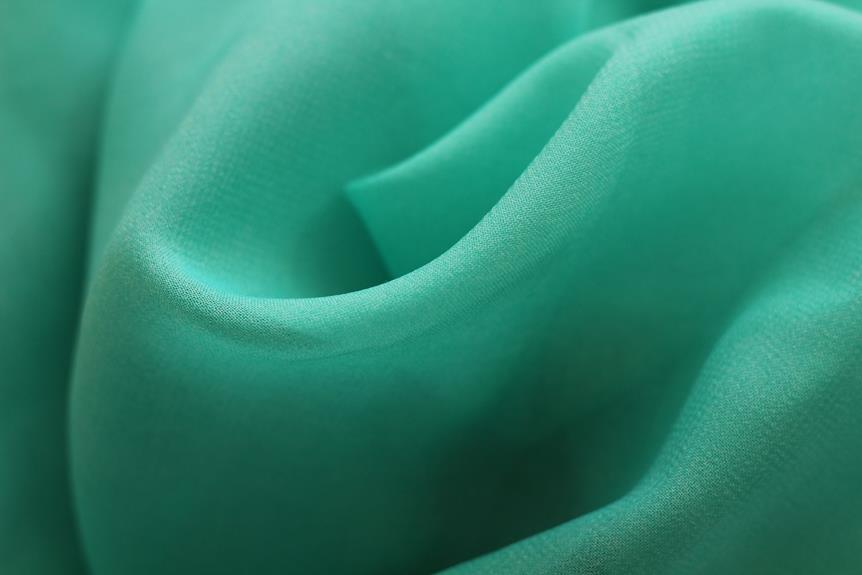You've probably heard that Lycra is just another name for polyester, but is that really the case? Let's dive into the details of these two popular materials to unravel the truth.
Understanding the composition and properties of Lycra and polyester is key to mastering their differences. By exploring their unique applications, you'll gain a clear understanding of how these materials are distinct from each other.
So, is Lycra really polyester? Get ready to uncover the facts and gain a comprehensive understanding of these two versatile fabrics.
Key Takeaways
- Lycra is a brand name for a type of spandex, while polyester is a synthetic fiber commonly used in clothing.
- Lycra has superior stretch and recovery properties compared to polyester.
- Lycra is commonly used in form-fitting garments and sportswear, while polyester is preferred for performance-oriented clothing and outdoor gear.
- Lycra offers a snug and body-hugging fit, while polyester is breathable and moisture-wicking.
Understanding Lycra and Polyester
If you're wondering about the differences between Lycra and polyester, let's start by clarifying that Lycra is a brand name for a type of spandex, while polyester is a synthetic fiber commonly used in clothing.
Lycra, also known as elastane, is renowned for its exceptional stretch and recovery properties. It can stretch up to seven times its initial length and return to its original state, making it ideal for form-fitting garments and sportswear. This unique ability to retain its shape provides comfort and flexibility for a wide range of body movements, making it a popular choice for activewear and swimwear.
On the other hand, polyester is highly versatile and widely used in various types of clothing due to its durable, wrinkle-resistant, and quick-drying nature. It's commonly blended with other fibers to enhance the fabric's strength and durability. Polyester's moisture-wicking properties also make it suitable for athletic and outdoor apparel.
Understanding the distinct properties of Lycra and the versatile uses of polyester can help you make informed decisions when choosing clothing that best suits your needs.
Key Differences Between Lycra and Polyester
Lycra and polyester differ in their stretch and recovery properties, making them distinct materials for clothing. When comparing the two, it's important to note the following key differences:
- Stretch: Lycra, also known as spandex, is renowned for its exceptional stretch, providing excellent flexibility and comfort in clothing. On the other hand, while polyester can be blended with spandex to add stretch, it doesn't possess the same inherent elasticity as Lycra.
- Recovery: Lycra has superior recovery properties, meaning it can retain its shape even after being stretched repeatedly. In contrast, polyester, while durable, may not bounce back to its original form as effectively as Lycra.
- Applications: Lycra finds extensive use in activewear, swimwear, and form-fitting garments due to its stretch and recovery capabilities. Polyester, with its moisture-wicking and quick-drying characteristics, is often preferred for performance-oriented clothing and outdoor gear.
- Comfort: While Lycra offers a snug and body-hugging fit, polyester is prized for its breathability and moisture management, catering to different comfort needs in clothing.
Understanding these distinctions can help you make informed choices when selecting clothing for different activities and purposes.
The Composition of Lycra and Polyester
Lycra is a synthetic blend commonly used in fabrics for its stretch and recovery properties, while polyester is a versatile material often found in clothing and textiles.
Understanding the composition of Lycra and polyester can help you make informed choices when it comes to selecting clothing and understanding their performance characteristics.
Let's explore the unique properties of these materials and how they contribute to the overall quality of the fabric.
Lycra's Synthetic Blend
Understanding the synthetic blend of Lycra and polyester is crucial for anyone seeking to comprehend the properties and characteristics of these materials. Lycra, also known as spandex, is a synthetic fiber known for its exceptional elasticity, while polyester is a durable, wrinkle-resistant synthetic fiber. When combined, they create a fabric with unique qualities that make it ideal for various applications.
The blend properties of Lycra and polyester result in a fabric that offers excellent stretch and recovery, providing comfort and flexibility.
The combination enhances the fabric's durability, making it resistant to abrasion and tearing, ensuring longevity.
The synthetic blend results in a fabric that's easy to care for, as it's machine washable and quick-drying.
The blend also provides moisture-wicking properties, keeping you dry and comfortable during physical activities.
Polyester in Fabric
The composition of Lycra and polyester in fabric creates a versatile blend with unique properties and characteristics. Polyester fiber, a synthetic material, is widely used in the textile industry due to its durability, wrinkle resistance, and easy-care properties. When combined with Lycra, which provides elasticity and comfort, the resulting fabric offers the best of both worlds. Below is a table illustrating the key characteristics of polyester and Lycra in fabric:
| Polyester Fiber | Lycra |
|---|---|
| Durable | Elastic |
| Wrinkle-resistant | Comfortable |
| Easy-care | Enhances shape |
This blend is popular in activewear, swimwear, and form-fitting garments due to its ability to maintain shape, provide flexibility, and withstand frequent use. Understanding the composition of Lycra and polyester in fabric allows you to make informed decisions when selecting clothing for various activities.
Properties of Lycra Versus Polyester
When comparing Lycra and polyester, it's important to consider their properties.
Lycra is known for its durability and elasticity, making it ideal for clothing that requires a snug fit and the ability to stretch.
On the other hand, polyester is valued for its moisture-wicking and breathability, allowing for comfort during physical activities.
Both materials offer versatility in clothing, but understanding their specific properties can help you make informed choices when selecting garments.
Durability and Elasticity
You'll find that Lycra and polyester differ in their durability and elasticity, making them suitable for different types of clothing. When comparing the two materials, consider the following:
- Lycra offers exceptional stretchability, making it ideal for form-fitting garments that require flexibility and movement.
- Polyester is known for its durability, making it suitable for sturdy, long-lasting clothing items such as outerwear and sportswear.
Lycra's elasticity allows for comfortable, body-hugging designs, perfect for activewear and swimwear that require freedom of movement.
- Polyester's resilience makes it an excellent choice for items that need to maintain their shape and withstand frequent washing and wear.
Understanding the unique properties of Lycra and polyester can help you make informed decisions when selecting the right fabric for your clothing needs.
Moisture-Wicking and Breathability
Incorporating moisture-wicking and breathability into your clothing is crucial. Understanding how Lycra and polyester differ in these properties can help you choose the right fabric for your active lifestyle.
Polyester is known for its moisture-wicking capabilities. It draws sweat away from your skin and allows it to evaporate quickly, which is essential for maintaining comfort during intense workouts.
On the other hand, Lycra has exceptional breathability. It enhances athletic performance by allowing air to circulate through the fabric, keeping you cool and dry.
When it comes to fabric technology, both Lycra and polyester play vital roles in improving athletic wear. While polyester excels at moisture-wicking, Lycra's breathability is equally important for maintaining optimal comfort during physical activities.
Understanding these differences can help you make informed decisions when choosing activewear for your active lifestyle.
Versatility in Clothing
Wondering how Lycra and polyester differ in their versatility for clothing? When it comes to versatile fabrics, Lycra and polyester offer distinct benefits for keeping up with fashion trends. Here's a comparison to help you understand their properties:
- Stretch and Flexibility: Lycra provides exceptional stretch, making it ideal for form-fitting and flexible clothing, while polyester offers moderate stretch and is better suited for structured garments.
- Breathability: Lycra is breathable, ensuring comfort during physical activities, whereas polyester may not offer the same level of breathability.
- Durability and Maintenance: Polyester is known for its durability and ease of care, while Lycra may require more delicate handling to maintain its stretch properties.
- Versatility in Use: Lycra is often used in activewear and sportswear, while polyester is favored for a wide range of clothing, from casual to formal attire.
Exploring the Applications of Lycra and Polyester
You can find a wide range of applications for Lycra and polyester in various industries, from fashion to sports and beyond. Lycra, known for its exceptional elasticity, is extensively used in sportswear, swimwear, and form-fitting garments due to its ability to stretch and recover its shape. It provides comfort and flexibility, making it a popular choice for activewear and compression garments.
Polyester, on the other hand, is widely used in a variety of applications, including clothing, home furnishings, and industrial fabrics. Its durability, wrinkle resistance, and quick-drying properties make it suitable for outdoor apparel, workwear, and various accessories.
In fabric comparison, Lycra is often blended with other materials to enhance stretch and recovery in fabrics, while polyester is commonly blended with natural fibers such as cotton to improve the fabric's strength and wrinkle resistance. The combination of these materials results in fabrics that offer the benefits of both Lycra and polyester, making them suitable for a wide range of applications, from everyday clothing to specialized sportswear.
Whether you're looking for clothing that offers flexibility and comfort or durable, low-maintenance fabrics, Lycra and polyester blends have you covered.
Conclusion: Lycra and Polyester Unraveled
As we unravel the properties and applications of Lycra and polyester, you'll gain a deeper understanding of their unique qualities and the versatility they offer in various fabric blends.
Lycra and spandex are actually the same material, with Lycra being the brand name and spandex being the generic term. Both Lycra and polyester are widely used in athletic and performance wear due to their moisture-wicking properties and stretch capabilities.
When blended together, they create a fabric that's durable, breathable, and provides excellent shape retention. This makes it ideal for activewear and swimwear, providing the perfect combination of comfort and performance.
Furthermore, the combination of Lycra and polyester results in a fabric that's easy to care for and resistant to wrinkles, making it a practical choice for everyday clothing.
In conclusion, the unique properties of Lycra and polyester, especially when used in combination, offer a wide range of benefits for various garment applications.
- Enhanced performance
- Durability and longevity
- Comfort and flexibility
- Easy care and maintenance
Frequently Asked Questions
How Do Lycra and Polyester Compare in Terms of Environmental Impact and Sustainability?
When comparing lycra and polyester in terms of environmental impact and sustainability, consider that lycra is a type of spandex, usually made from polyurethane, while polyester is a synthetic fiber. Recycling initiatives are key for both materials to improve their environmental impact.
Can Lycra and Polyester Be Blended Together to Create a Fabric With Combined Properties?
When blending Lycra and polyester, you create a fabric with combined properties that enhance fabric performance. The flexibility of Lycra and the durability of polyester work together, resulting in a versatile and resilient textile.
What Are the Potential Health Concerns Associated With Wearing Clothing Made From Lycra or Polyester?
Potential allergies and skin irritation are concerns when wearing clothing made from lycra or polyester. Pay attention to fabric content and prioritize natural fibers. Consider washing new garments before wearing to minimize potential skin reactions.
Are There Any Special Care Instructions for Maintaining the Quality of Lycra and Polyester Garments?
To maintain the quality of your lycra and polyester garments, follow special care instructions. Check washing labels for fabric maintenance guidance. Use gentle detergents, cold water, and avoid high heat when washing and drying to preserve the integrity of lycra and polyester.
How Do the Costs of Producing and Purchasing Lycra and Polyester Fabrics Compare?
When comparing the costs of producing and purchasing lycra and polyester fabrics, consider market demand. Lycra is often pricier due to its stretch and recovery properties, whereas polyester is more cost-effective.
- A Guide to Chinese Laid Scrims for Industrial Applications - June 26, 2025
- Why Museums Use Sheer Scrim Fabric for Exhibits and Displays - June 26, 2025
- Technical Guide: Polyester Scrim Fabric Specifications for Manufacturers - June 26, 2025







